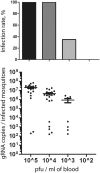A Zika virus from America is more efficiently transmitted than an Asian virus by Aedes aegypti mosquitoes from Asia
- PMID: 28450714
- PMCID: PMC5430906
- DOI: 10.1038/s41598-017-01282-6
A Zika virus from America is more efficiently transmitted than an Asian virus by Aedes aegypti mosquitoes from Asia
Abstract
Zika is a mosquito-borne disease associated with neurological disorders that causes an on-going pandemic. The first outbreak was recorded in Micronesia in 2007, then in French Polynesia in 2014 from which it spread to South America in 2015 and ignited a widespread epidemic. Interestingly, Zika outbreaks in Asia remained of moderate intensity although the virus is circulating. To understand these epidemiological variations, we investigated the entomological determinants of ZIKV transmission in Asia. We used oral infection of mosquitoes collected in Singapore to identify the vector species, to quantify the blood infection threshold and to compare transmissibility between an Asian ZIKV strain (H/PF13) and an American strain collected in Brazil (BE H 815744). We have confirmed the vector status of Aedes aegypti and determined that 103 pfu/ml of blood is sufficient to infect mosquitoes. We showed that only the American strain was present in the saliva 3 days post-infection, and that this strain had a 30-40% higher rate of saliva infection in Ae. aegypti from 3 to 14 days post-infection than the Asian strain. Our data suggests that American strains are more efficiently transmitted than Asian strains, which raises concerns about the introduction of American strains in Asia.
Conflict of interest statement
The authors declare that they have no competing interests.
Figures



Similar articles
-
Transmission potential of African, Asian and American Zika virus strains by Aedes aegypti and Culex quinquefasciatus from Guadeloupe (French West Indies).Emerg Microbes Infect. 2019;8(1):699-706. doi: 10.1080/22221751.2019.1615849. Emerg Microbes Infect. 2019. PMID: 31109248 Free PMC article.
-
Evidence for infection but not transmission of Zika virus by Aedes albopictus (Diptera: Culicidae) from Spain.Parasit Vectors. 2019 May 3;12(1):204. doi: 10.1186/s13071-019-3467-y. Parasit Vectors. 2019. PMID: 31053164 Free PMC article.
-
Zika virus outbreak in the Pacific: Vector competence of regional vectors.PLoS Negl Trop Dis. 2018 Jul 17;12(7):e0006637. doi: 10.1371/journal.pntd.0006637. eCollection 2018 Jul. PLoS Negl Trop Dis. 2018. PMID: 30016372 Free PMC article.
-
The Convergence of a Virus, Mosquitoes, and Human Travel in Globalizing the Zika Epidemic.J Community Health. 2016 Jun;41(3):674-9. doi: 10.1007/s10900-016-0177-7. J Community Health. 2016. PMID: 26969497 Review.
-
An updated review of Zika virus.J Clin Virol. 2016 Nov;84:53-58. doi: 10.1016/j.jcv.2016.09.012. Epub 2016 Oct 3. J Clin Virol. 2016. PMID: 27721110 Review.
Cited by
-
Vector Competence of Aedes aegypti, Aedes albopictus and Culex quinquefasciatus from Brazil and New Caledonia for Three Zika Virus Lineages.Pathogens. 2020 Jul 16;9(7):575. doi: 10.3390/pathogens9070575. Pathogens. 2020. PMID: 32708536 Free PMC article.
-
Vector competence of Culex mosquitoes (Diptera: Culicidae) in Zika virus transmission: an integrative review.Rev Panam Salud Publica. 2020 Feb 3;44:e7. doi: 10.26633/RPSP.2020.7. eCollection 2020. Rev Panam Salud Publica. 2020. PMID: 32025230 Free PMC article. Review.
-
Pandemic Zika: A Formidable Challenge to Medicine and Public Health.J Infect Dis. 2017 Dec 16;216(suppl_10):S857-S859. doi: 10.1093/infdis/jix383. J Infect Dis. 2017. PMID: 29267908 Free PMC article. No abstract available.
-
Quantifying the risk of Zika virus spread in Asia during the 2015-16 epidemic in Latin America and the Caribbean: A modeling study.Travel Med Infect Dis. 2020 Jan-Feb;33:101562. doi: 10.1016/j.tmaid.2020.101562. Epub 2020 Jan 26. Travel Med Infect Dis. 2020. PMID: 31996323 Free PMC article.
-
Evidence of Zika virus horizontal and vertical transmission in Aedes albopictus from Spain but not infectious virus in saliva of the progeny.Emerg Microbes Infect. 2020 Dec;9(1):2236-2244. doi: 10.1080/22221751.2020.1830718. Emerg Microbes Infect. 2020. PMID: 33008282 Free PMC article.
References
Publication types
MeSH terms
LinkOut - more resources
Full Text Sources
Other Literature Sources
Medical

